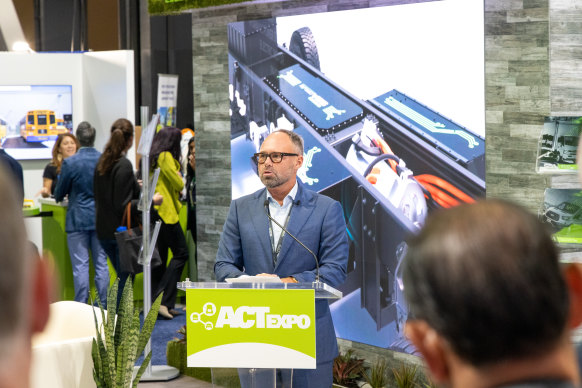Mack, he says, did more than 800,000 kilometres of equivalent durability testing on SEA’s technology in their trucks. That was just one of the many boxes ticked by the big truck manufacturer. “They checked everything about our suppliers: from their financial status; to where they get raw materials from; to their ability to provide the scale needed long-term. We are now a tier-one supplier to the automotive space,” he said.
SEA wasn’t always this successful. Three years ago, the company was on the verge of collapse when one of Australia’s big four banks called in a $4.5 million trade finance loan, giving it six months to pay it back.
Fairweather blames then prime minister Scott Morrison for devastating confidence in the electric vehicle industry. Morrison and small business minister Michaelia Cash attempted to crucify Labor’s policy for increasing EV sales, claiming electrification would “end the weekend” and the opposition was intent on taking away tradies’ utes.

SEA Electric boss Tony Fairweather.Credit:
“Australia was a very tough, tough place to survive. We wouldn’t have survived if we had stayed. It’s as simple as that,” he says.
The lack of clear EV policy and fiscal conservatism from the banks prompted Fairweather to flee to the US and re-domicile the company in Delaware, where he found a different environment. There he raised $US75 million ($108 million) from investors to keep SEA alive in Australia and fund its significant US expansion.
Loading
Those funds will propel the decade-old start-up into a $1.5 billion technology firm. “We are now in a position, because of the volume, where we will be EBITA positive later this year and free cash flow positive early next year.”
SEA installs its electric drive system into light commercial vehicles out of its Victorian factory in Dandenong, where most of Hino’s Australian electric trucks will be fitted out. The company has previously tied up a deal worth almost $1 billion to supply 8500 electrified Toyota Hilux and Land Cruiser utes to the Australian mining industry. “We’re still building trucks here and we’ll continue to do that, but it’s being funded by the US,” says Fairweather.
The federal government this week rolled out its National Electric Vehicle Strategy, a policy that prioritises passenger vehicles. Fairweather said the scheme failed to address a “fantastic opportunity” to also electrify commercial vehicles. “It is very disappointing, but I’m not particularly surprised,” he said.
Twenty per cent of emissions in Australia come from the transport industry. “We’ve got manufacturing already in Australia. We’ve got strong appetite from our customer base. Every [fossil fuel] truck you take off the road can have the equivalent benefit of removing up to 30 cars from a CO2 perspective. Plus you get the added benefit of taking the known carcinogens emitted from diesel engines out of the city environment,” he said.
The Morning Edition newsletter is our guide to the day’s most important and interesting stories, analysis and insights. Sign up here.
Stay connected with us on social media platform for instant update click here to join our Twitter, & Facebook
We are now on Telegram. Click here to join our channel (@TechiUpdate) and stay updated with the latest Technology headlines.
For all the latest Business News Click Here
For the latest news and updates, follow us on Google News.
